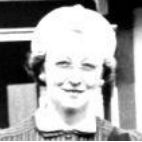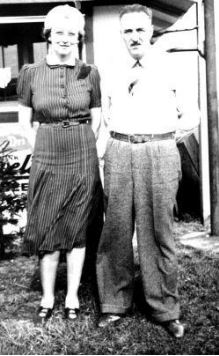Marie Zimmerman The First Woman Radio Station Owner

Marie Zimmerman probably did not plan to be a radio pioneer. But when station WIAE in Vinton, IA received a license from the Department of Commerce in mid-July 1922, she became the first woman to own a radio station.
It was a time when women generally were expected to be homemakers and, while Marie volunteered for the Red Cross during the war, she seems to have had no plans to work fulltime – in fact, on her husband Robert’s 1918 draft card, he stated that he was the sole support of his wife. But something changed for the young couple in 1920; Robert’s brother Carroll came from Illinois to visit, and he introduced them to a new hobby – amateur radio. Both were instantly hooked.
First Generation American
Marie Ciesielski was born in Iowa on March 1894. Her parents, Andrew and Julia, had emigrated from Germany and settled on a farm in Jesup, in Buchanan County. Marie was the second of eleven children. In 1915, she married Robert Zimmerman, a native of Taylorville IL who had come to Independence, IA to work in construction.

Marie Zimmerman
(1894-1973)
Robert, who had the nickname “Zim,” pursued an interest in electronics, becoming the city electrician in nearby Vinton, while Marie focused on learning as much as she could about how radio worked.
From Listeners to Broadcasters
At first, she and her husband built their own small receiving set. But by 1921, what was then called “radiophone” broadcasting had come to Iowa, and Marie and her husband began listening in to it. Zim soon found creative ways to put a receiver in their car, so they could enjoy the music and speeches from distant stations.
Early in 1922, Marie decided it might be fun to operate their own radiophone station, and her husband agreed. Although neither he nor Marie had the $300 that the equipment would cost, Zim set out to raise enough money to buy the necessary equipment. A sympathetic article in the local Vinton newspaper called attention to their plan, and the money was raised.
On July 21, 1922, the Department of Commerce (which licensed stations before the creation of the Federal Radio Commission) issued a limited commercial license to “Mrs. Robert E. Zimmerman” of “Venton” Iowa, to operate station WIAE. The name of the city may have been misspelled – and the station went on the air with only 40 Watts – but the people in the area were very pleased to have their own local station (in those early days of broadcasting, 40 Watts could go a considerable distance).
Local Radio
The station itself was in a separate building, adjacent to their home; Zim also built a special studio for the performers. Marie was able to organize some local musicians, and they became WIAE’s regular orchestra. The studio also had a Brunswick phonograph so records could be played when there were no live guests available.
Like most of the small stations of that era, WIAE was not on the air every day. It broadcast on Tuesdays, Thursdays, and Saturdays, usually from 9 PM to 10 PM, featuring music and news. On Wednesdays at 8 PM, there was a band concert; and on occasional Sundays at 2:30 PM, there was another live concert.
WIAE also became a source for local events. In late August, Zim set up a remote broadcast from the Benton County Farm Bureau’s annual picnic. Few Vinton residents had ever seen a live radio broadcast, and even the local newspapers reported on it. WIAE also provided political news.
A Lady At the Top
But unlike the other stations of that time, Zim was not the one who ran things; Marie was the person in charge. Zim had bought the equipment and installed the transmitter, but Marie did the rest – she booked the guests, found the performers, and even did the announcing. (Marie told a reporter that she hoped to expand the broadcast day, and she wanted to offer morning concerts for school-children, so they could learn music appreciation at a young age.)
Within several weeks of the station going on the air, Marie was getting fan mail from as far away as Connecticut and Louisiana, proving that the station’s signal could travel a surprising number of miles.
By late 1922, many candidates had discovered that broadcasting a speech enabled them to reach a potentially larger audience. Among the first local candidates to use WIAE was Vernon J. Youel, Republican candidate for the office of country auditor. After he gave his talk in early November, he received a number of phone calls from listeners, and area newspapers wrote about the new innovation of campaigning by radio.
Difficult Times for a Tiny Station
Unfortunately for little stations like WIAE, late 1922 saw the radio craze take hold nationwide, as hundreds of new stations took to the air. In Iowa, several of those stations were bigger, more powerful, and better funded than WIAE, most notably WJAM in nearby Cedar Rapids, owned by the Cedar Rapids Gazette. WJAM was able to give listeners free radios as prizes; some of their contests offered the chance to win as much as $100 in cash (a large sum in those days).
In those years before spot commercials were common, more than a few radio entrepreneurs kept their stations out of their personal funds – until their money ran out. For Marie, too, running WIAE was a labor of love, but it was becoming more and more expensive. Soon the Zimmermans found themselves unable to compete.
By early 1923, the Zimmermans knew they could no longer afford the station’s expenses. Marie did not renew WIAE’s license in April (in those days, licenses were renewed every three months), and so the Department of Commerce officially deleted the station in late June. It had lasted not quite one year.
After Radio
After WIAE left the air, the Zimmermans left Vinton and moved to Kenosha, Wisconsin. Zim found some work in advertising, while Marie took a job in retail at Block’s Department Store. She would stay there, moving from saleslady up to buyer.

Marie and Robert “Zim” Zimmerman
While there is evidence that both remained fans of radio, neither was able to get back into broadcasting. After Zim died suddenly in December 1946, Marie moved back to the farm in Jesup, where she cared for her ailing mother, as well as several other siblings.
Marie Zimmerman died on 23 January 1973, at age 77. Half a century removed from WIAE, her obituary said nothing about her pioneering involvement in radio, nor did her relatives recall her even speaking about her days as a station owner. (In fact, when the 75th anniversary of WIAE occurred in August 1997, I wrote an article for Vinton’s newspaper, the Cedar Valley Times, and in researching Marie’s story, I spoke with several of her relatives. They said she was not the kind of person who would have bragged about her achievements. Perhaps she felt that since the station did not last very long, it was nothing special. They were quite surprised to learn that she had been the first woman to own a station.) Although WIAE’s time on the air was short – as was life for many early broadcasters – what Marie Zimmerman did in radio’s early days was unique. With a supportive husband and a shoestring budget, she proved to the local community that even a small station could have an impact.
And as a reporter who visited her station wrote, “Mrs Zimmerman is … the first to show [the men] what a woman can do in radio.”
– – –
Donna L. Halper is a media historian, educator, and radio consultant. She is the author of four books and many articles about the history of broadcasting. Contact her at dlh@donnahalper.com
